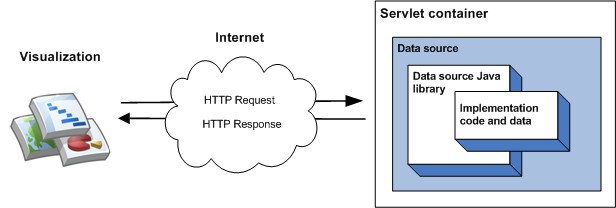ไลบรารีแหล่งข้อมูลภาพของ Google ช่วยให้ สร้างแหล่งข้อมูลการแสดงภาพได้อย่างง่ายดาย ไลบรารีนี้จะนําโปรโตคอลสายเคเบิลของ Google คุณสามารถไปที่ API และภาษาในการค้นหา คุณเขียนเฉพาะโค้ดที่จําเป็นต่อการทําให้ข้อมูลพร้อมใช้งานสําหรับคลังในรูปแบบตารางข้อมูล ตารางข้อมูลคือตารางค่าสองมิติที่ทุกคอลัมน์อยู่ในประเภทเดียว การเขียนรหัสที่ต้องการนั้นทําได้ง่ายๆ ด้วยการจัดสรรชั้นเรียนนามธรรมและตัวช่วย
การปรับไลบรารีให้เรียบง่ายที่สุดคือการรับช่วงมาจากคลาสเดียว โดยใช้ฟังก์ชันสมาชิกและเรียกใช้แหล่งข้อมูลเป็นเซิร์ฟเล็ตภายในคอนเทนเนอร์เซิร์ฟเล็ต ในการใช้งานที่ง่ายที่สุด ลําดับเหตุการณ์ต่อไปนี้จะเกิดขึ้นเมื่อการแสดงภาพค้นหาแหล่งข้อมูล
- คอนเทนเนอร์ของเซิร์ฟเล็ตจะจัดการคําค้นหาและส่งไปยังไลบรารี Java ของแหล่งข้อมูล
- ไลบรารีจะแยกวิเคราะห์การค้นหา
- โค้ดที่ใช้หรือโค้ดที่คุณเขียนจะส่งตารางข้อมูลกลับไปยังไลบรารี
- ไลบรารีจะดําเนินการค้นหาในตารางข้อมูล
- ไลบรารีจะแสดงผลตารางข้อมูลลงในคําตอบที่ ต้องการของภาพ
- คอนเทนเนอร์ของเซิร์ฟเล็ตจะแสดงการตอบกลับไปยังการแสดงภาพ
ซึ่งจะแสดงอยู่ในแผนภาพต่อไปนี้

ส่วนการเริ่มต้นใช้งานแหล่งข้อมูลอธิบายวิธีใช้แหล่งข้อมูลประเภทนี้
ข้อมูลที่แสดงโดยแหล่งข้อมูลจะระบุอยู่ในโค้ดการนําไปใช้ของคุณ ซึ่งใช้ได้กับข้อมูลคงที่เพียงเล็กน้อย สําหรับชุดข้อมูลขนาดใหญ่ คุณอาจต้องใช้ที่เก็บข้อมูลภายนอก เช่น ไฟล์หรือฐานข้อมูลภายนอก หากแหล่งข้อมูลใช้ที่เก็บข้อมูลภายนอก ลําดับเหตุการณ์ต่อไปนี้จะเกิดขึ้นเมื่อมีการแสดงภาพแหล่งข้อมูล
- คอนเทนเนอร์ของเซิร์ฟเล็ตจะจัดการคําค้นหาและส่งไปยังไลบรารี Java ของแหล่งข้อมูล
- ไลบรารีจะแยกวิเคราะห์การค้นหา
- โค้ดการใช้งาน - โค้ดที่คุณเขียนจะอ่านข้อมูลที่เก็บไว้ในที่เก็บข้อมูลและแสดงผลตารางข้อมูลไปยังไลบรารี หากชุดข้อมูลมีขนาดใหญ่และที่เก็บข้อมูลมีความสามารถในการค้นหา คุณสามารถใช้ความสามารถดังกล่าวเพื่อเพิ่มประสิทธิภาพของแหล่งข้อมูลได้
- ไลบรารีจะดําเนินการค้นหาในตารางข้อมูล
- ไลบรารีจะแสดงผลตารางข้อมูลลงในคําตอบที่ ต้องการของภาพ
- คอนเทนเนอร์ของเซิร์ฟเล็ตจะแสดงการตอบกลับไปยังการแสดงภาพ
ซึ่งจะแสดงอยู่ในแผนภาพต่อไปนี้

ส่วนการใช้ที่เก็บข้อมูลภายนอกอธิบายวิธีนําแหล่งข้อมูลประเภทนี้ไปใช้
